Methoprene-Induced Genes in Workers of Formosan Subterranean Termites (Coptotermes formosanus Shiraki)
Abstract
1. Introduction
2. Materials and Methods
2.1. Methoprene Bioassay
2.2. RNA Extraction and Sequencing
2.3. De Novo Transcriptome Assembly and Annotation
2.4. Analysis of Samples Relationship
2.5. Analysis of Differentially Expressed Genes (DEGs) between Treatment
2.6. Validation of RNA-Seq Results
2.7. GO and KEGG Pathway Enrichment Analysis
3. Results
3.1. Sequencing Quality and De Novo Assembly of the Transcriptome
3.2. Correlation of Samples
3.3. DEGs between Treatments
3.4. Validation of RNA-Seq Results
3.5. Gene Ontology (GO) Enrichment Analysis
3.6. KEGG Pathway Enrichment Analysis
4. Discussion
5. Conclusions
Supplementary Materials
Author Contributions
Funding
Conflicts of Interest
Data Availability
References
- Ament, S.A.; Corona, M.; Pollock, H.S.; Robinson, G.E. Insulin signaling is involved in the regulation of worker division of labor in honey bee colonies. Proc. Natl. Acad. Sci. USA 2008, 105, 4226–4231. [Google Scholar] [CrossRef]
- Evans, J.D.; Wheeler, D.E. Differential gene expression between developing queens and workers in the honey bee, Apis mellifera. Proc. Natl. Acad. Sci. USA 1999, 96, 5575–5580. [Google Scholar] [CrossRef]
- Yan, H.; Simola, D.F.; Bonasio, R.; Liebig, J.; Berger, S.L.; Reinberg, D. Eusocial insects as emerging models for behavioural epigenetics. Nat. Rev. Genet. 2014, 15, 677–688. [Google Scholar] [CrossRef] [PubMed]
- Edwards, R.; Mill, A.E. Termites in Buildings. Their Biology and Control; Rentokil Ltd.: East Grinstead, UK, 1986. [Google Scholar]
- Cornette, R.; Gotoh, H.; Koshikawa, S.; Miura, T. Juvenile hormone titers and caste differentiation in the damp-wood termite Hodotermopsis sjostedti (Isoptera, Termopsidae). J. Insect Physiol. 2008, 54, 922–930. [Google Scholar] [CrossRef] [PubMed]
- Koshikawaa, S.; Cornettea, R.; Hojoa, M.; Maekawaa, K.; Matsumotoa, T.; Miuraa, T. Screening of genes expressed in developing mandibles during soldier differentiation in the termite Hodotermopsis sjostedti. FEBS Lett. 2005, 579, 1365–1370. [Google Scholar] [CrossRef] [PubMed]
- Miura, T.; Kamikouch, A.; Sawata, M.; Takeuch, H.; Nator, S.; Kubo, T.; Matsumoto, T. Soldier caste-specific gene expression in the mandibular glands of Hodotermopsis japonica (Isoptera: Termopsidae). Proc. Natl. Acad. Sci. USA 1999, 96, 13874–13879. [Google Scholar] [CrossRef]
- Scharf, M.E.; Wuscharf, D.; Pittendrigh, B.R.; Bennett, G.W. Caste- and development-associated gene expression in a lower termite. Genome Biol. 2003, 4, R62. [Google Scholar] [CrossRef]
- Yaguchi, H.; Shigenobu, S.; Hayashi, Y.; Miyazaki, S.; Toga, K.; Masuoka, Y.; Maekawa, K. A lipocalin protein, Neural Lazarillo, is key to social interactions that promote termite soldier differentiation. Proc. R. Soc. B Biol. Sci. 2018, 285. [Google Scholar] [CrossRef]
- Masuoka, Y.; Yaguchi, H.; Toga, K.; Shigenobu, S.; Maekawa, K. TGFβ signaling related genes are involved in hormonal mediation during termite soldier differentiation. PLoS Genet. 2018, 14, e1007338. [Google Scholar] [CrossRef]
- Rust, M.K.; Su, N.-Y. Managing social insects of urban importance. Annu. Rev. Entomol. 2012, 57, 355–375. [Google Scholar] [CrossRef]
- Haverty, M.I. The proportion of soldiers in termite colonies: A list and a bibliography. Sociobiology 1977, 2, 199–216. [Google Scholar]
- Hrdý, I.; Křeček, J. Development of superfluous soldiers induced by juvenile hormone analogues in the termite, Reticulitermes lucifugus santonensis. Insectes Sociaux 1972, 19, 105–109. [Google Scholar] [CrossRef]
- Maekawa, K.; Hayashi, Y.; Lee, T.; Lo, N. Presoldier differentiation of Australian termite species induced by juvenile hormone analogues. Austral Entomol. 2014, 53, 138–143. [Google Scholar] [CrossRef]
- Cornette, R.; Koshikawa, S.; Hojo, M.; Matsumoto, T.; Miura, T. Caste-specific cytochrome P450 in the damp-wood termite Hodotermopsis sjostedti (Isoptera, Termopsidae). Insect Mol. Biol. 2006, 15, 235–244. [Google Scholar] [CrossRef] [PubMed]
- Hattori, A.; Sugime, Y.; Sasa, C.; Miyakawa, H.; Ishikawa, Y.; Miyazaki, S.; Okada, Y.; Cornette, R.; Lavine, L.C.; Emlen, D.J.; et al. Soldier morphogenesis in the damp-wood termite is regulated by the insulin signaling pathway. J. Exp. Zool. Part B 2013, 320, 295–306. [Google Scholar] [CrossRef] [PubMed]
- Masuoka, Y.; Yaguchi, H.; Suzuki, R.; Maekawa, K. Knockdown of the juvenile hormone receptor gene inhibits soldier-specific morphogenesis in the damp-wood termite Zootermopsis nevadensis (Isoptera: Archotermopsidae). Insect Biochem. Mol. 2015, 64, 25–31. [Google Scholar] [CrossRef] [PubMed]
- Tarver, M.R.; Coy, M.R.; Scharf, M.E. Cyp15F1: A novel cytochrome P450 gene linked to juvenile hormone-dependent caste differention in the termite Reticulitermes flavipes. Arch. Insect Biochem. 2012, 80, 92–108. [Google Scholar] [CrossRef]
- Zhou, X.; Oi, F.M.; Scharf, M.E. Social exploitation of hexamerin: RNAi reveals a major caste-regulatory factor in termites. Proc. Natl. Acad. Sci. USA 2006, 103, 4499–4504. [Google Scholar] [CrossRef]
- Suzuki, R.; Yaguchi, H.; Maekawa, K. Histone modifying genes are involved in the molting period during soldier differentiation in Zootermopsis nevadensis. J. Insect Physiol. 2019, 117, 103892. [Google Scholar] [CrossRef]
- Sugime, Y.; Oguchi, K.; Gotoh, H.; Hayashi, Y.; Matsunami, M.; Shigenobu, S.; Koshikawa, S.; Miura, T. Termite soldier mandibles are elongated by dachshund under hormonal and Hox gene controls. Development 2019, 146, dev171942. [Google Scholar] [CrossRef]
- Su, N.-Y.; Tamashiro, M.; Haverty, M.I. Effects of three insect growth regulators, feeding substrates, and colony origin on survival and presoldier production of the Formosan subterranean termite (Isoptera: Rhinotermitidae). J. Econ. Entomol. 1985, 78, 1259–1263. [Google Scholar] [CrossRef]
- Howard, R.W.; Haverty, M.I. Defaunation, mortality and soldier differentiation: Concentration effects of methoprene in a termite. Sociobiology 1978, 3, 73–77. [Google Scholar]
- Haverty, M.I.; Su, N.-Y.; Tamashiro, M.; Yamamoto, R. Concentration-dependent presoldier induction and feeding deterrency: Potential of two insect growth regulators for remedial control of the Formosan subterranean termite (Isoptera: Rhinotermitidae). J. Econ. Entomol. 1989, 82, 1370–1374. [Google Scholar] [CrossRef]
- Park, Y.I.; Raina, A. Factors regulating caste differentiation in the Formosan subterraneantermite with emphasis on soldier formation. Sociobiology 2003, 41, 49–60. [Google Scholar]
- Bourguignon, T.; Lo, N.; Cameron, S.L.; Šobotník, J.; Hayashi, Y.; Shigenobu, S.; Watanabe, D.; Roisin, Y.; Miura, T.; Evans, T.A. The evolutionary history of termites as inferred from 66 mitochondrial genomes. Mol. Biol. Evol. 2014, 32, 406–421. [Google Scholar] [CrossRef]
- Chouvenc, T.; Li, H.-F.; Austin, J.W.; Bordereau, C.; Bourguignon, T.; Cameron, S.L.; Cancello, E.M.; Constantino, R.; Costa-Leonardo, A.M.; Eggleton, P.; et al. Revisiting Coptotermes (Isoptera: Rhinotermitidae): A global taxonomic road map for species validity and distribution of an economically important subterranean termite genus. Syst. Entomol. 2016, 41, 299–306. [Google Scholar] [CrossRef]
- Jongepier, E.; Kemena, C.; Lopez-Ezquerra, A.; Belles, X.; Bornberg-Bauer, E.; Korb, J. Remodeling of the juvenile hormone pathway through caste-biased gene expression and positive selection along a gradient of termite eusociality. J. Exp. Zool. Part B 2018, 330, 296–304. [Google Scholar] [CrossRef]
- Cornette, R.; Matsumoto, T.; Miura, T. Histological analysis of fat body development and molting events during soldier differentiation in the damp-wood termite, Hodotermopsis sjostedti (Isoptera, Termopsidae). Zool. Sci. 2007, 24, 1066–1074. [Google Scholar] [CrossRef]
- Su, N.-Y.; Scheffrahn, R.H. A method to access, trap, and monitor field populations of the Formosan subterranean termite (Isoptera: Rhinotermitidae) in the urban environment. Sociobiology 1986, 12, 299–304. [Google Scholar]
- Langmead, B.; Salzberg, S.L. Fast gapped-read alignment with Bowtie 2. Nat. Methods 2012, 9, 357–359. [Google Scholar] [CrossRef]
- Grabherr, M.G.; Haas, B.J.; Yassour, M.; Levin, J.Z.; Thompson, D.A.; Amit, I.; Adiconis, X.; Fan, L.; Raychowdhury, R.; Zeng, Q.; et al. Full-length transcriptome assembly from RNA-Seq data without a reference genome. Nat. Biotechnol. 2011, 29, 644–652. [Google Scholar] [CrossRef] [PubMed]
- Conesa, A.; Götz, S.; García-Gómez, J.M.; Terol, J.; Talón, M.; Robles, M. Blast2GO: A universal tool for annotation, visualization and analysis in functional genomics research. Bioinformatics 2005, 21, 3674–3676. [Google Scholar] [CrossRef] [PubMed]
- Mortazavi, A.; Williams, B.A.; McCue, K.; Schaeffer, L.; Wold, B. Mapping and quantifying mammalian transcriptomes by RNA-Seq. Nat. Methods 2008, 5, 621–628. [Google Scholar] [CrossRef] [PubMed]
- Warnes, G.R.; Bolker, B.; Lumley, T.; Johnson, R.C. Gmodels: Various R Programming Tools for Model Fitting. R package version 2.18.1. 2018. Available online: https://CRAN.R-project.org/package=gmodels (accessed on 14 January 2020).
- Robinson, M.D.; McCarthy, D.J.; Smyth, G.K. edgeR: A Bioconductor package for differential expression analysis of digital gene expression data. Bioinformatics 2010, 26, 139–140. [Google Scholar] [CrossRef] [PubMed]
- Du, H.; Wu, W.; Huang, X.; Li, Z. Screening of reference genes for expression analysis in the study of soldier caste differentiation of Formosan subterranean termite Coptotermes formosanus Shiraki. PeerJ 2019, 7, e7981. [Google Scholar] [CrossRef]
- R Development CoreTeam. R: A Language and Environment for Statistical Computing; R Foundation for Statistical Computing: Vienna, Austria, 2016. [Google Scholar]
- Lüscher, M. Die Bedeutung des Juvenilhormons für die Differenzierung der Soldaten bei der Termite Kalotermes Flavicollis. In Proceedings of the Sixth International Congress of the IUSSI, Bern, Switzerland, 15–20 September 1969; pp. 165–170. [Google Scholar]
- Park, Y.I.; Raina, A.K. Juvenile hormone III titers and regulation of soldier caste in Coptotermes formosanus (Isoptera: Rhinotermitidae). J. Insect Physiol. 2004, 50, 561–566. [Google Scholar] [CrossRef]
- Liu, Y.; Henderson, G.; Mao, L.; Laine, R.A. Effects of temperature and nutrition on juvenile hormone titers of Coptotermes formosanus (Isoptera: Rhinotermitidae). Ann. Entomol. Soc. Am. 2005, 98, 732–737. [Google Scholar] [CrossRef]
- Yaguchi, H.; Suzuki, R.; Matsunami, M.; Shigenobu, S.; Maekawa, K. Transcriptomic changes during caste development through social interactions in the termite Zootermopsis nevadensis. Ecol. Evol. 2019, 9, 3446–3456. [Google Scholar] [CrossRef]
- Yaguchi, H.; Masuoka, Y.; Inoue, T.; Maekawa, K. Expressions of juvenile hormone biosynthetic genes during presoldier differentiation in the incipient colony of Zootermopsis nevadensis (Isoptera: Archotermopsidae). Appl. Entomol. Zool. 2015, 50, 497–508. [Google Scholar] [CrossRef]
- Tarver, M.R.; Schmelz, E.A.; Scharf, M.E. Soldier caste influences on candidate primer pheromone levels and juvenile hormone-dependent caste differentiation in workers of the termite Reticulitermes flavipes. J. Insect Physiol. 2011, 57, 771–777. [Google Scholar] [CrossRef]
- Jindra, M.; Palli, S.R.; Riddiford, L.M. The juvenile hormone signaling pathway in insect development. Annu. Rev. Entomol. 2013, 58, 181–204. [Google Scholar] [CrossRef] [PubMed]
- Li, K.; Jia, Q.Q.; Li, S. Juvenile hormone signaling-a mini review. Insect Sci. 2019, 26, 600–606. [Google Scholar] [CrossRef] [PubMed]
- Huang, Z.J.; Edery, I.; Rosbash, M. PAS is a dimerization domain common to Drosophila period and several transcription factors. Nature 1993, 364, 259–262. [Google Scholar] [CrossRef] [PubMed]
- Kang, P.; Chang, K.; Liu, Y.; Bouska, M.; Birnbaum, A.; Karashchuk, G.; Thakore, R.; Zheng, W.; Post, S.; Brent, C.S. Drosophila Kruppel homolog 1 represses lipolysis through interaction with dFOXO. Sci. Rep. 2017, 7, 16369. [Google Scholar] [CrossRef]
- Maekawa, K.; Nakamura, S.; Watanabe, D. Termite soldier differentiation in incipient colonies is related to parental proctodeal trophallactic behavior. Zool. Sci. 2012, 29, 213–218. [Google Scholar] [CrossRef]
- Li, S.; Yu, X.; Feng, Q. Fat Body Biology in the Last Decade. Annu. Rev. Entomol. 2019, 64, 315–333. [Google Scholar] [CrossRef]
- Liénard, M.A.; Lassancea, J.-M.X.S.; Paulmierb, I.; Picimbon, J.-F.; Löfstedt, C. Differential expression of cytochrome c oxidase subunit III gene in castes of the termite Reticulitermes santonensis. J. Insect Physiol. 2006, 52, 551–557. [Google Scholar] [CrossRef]
- Tian, H.; Vinson, S.B.; Coates, C.J. Differential gene expression between alate and dealate queens in the red imported fire ant, Solenopsis invicta Buren (Hymenoptera: Formicidae). Insect Biochem. Mol. 2004, 34, 937–949. [Google Scholar] [CrossRef]
- Helvig, C.; Koener, J.F.; Unnithan, G.C.; Feyereisen, R. CYP15A1, the cytochrome P450 that catalyzes epoxidation of methyl farnesoate to juvenile hormone III in cockroach corpora allata. Proc. Natl. Acad. Sci. USA 2004, 101, 4024–4029. [Google Scholar] [CrossRef]
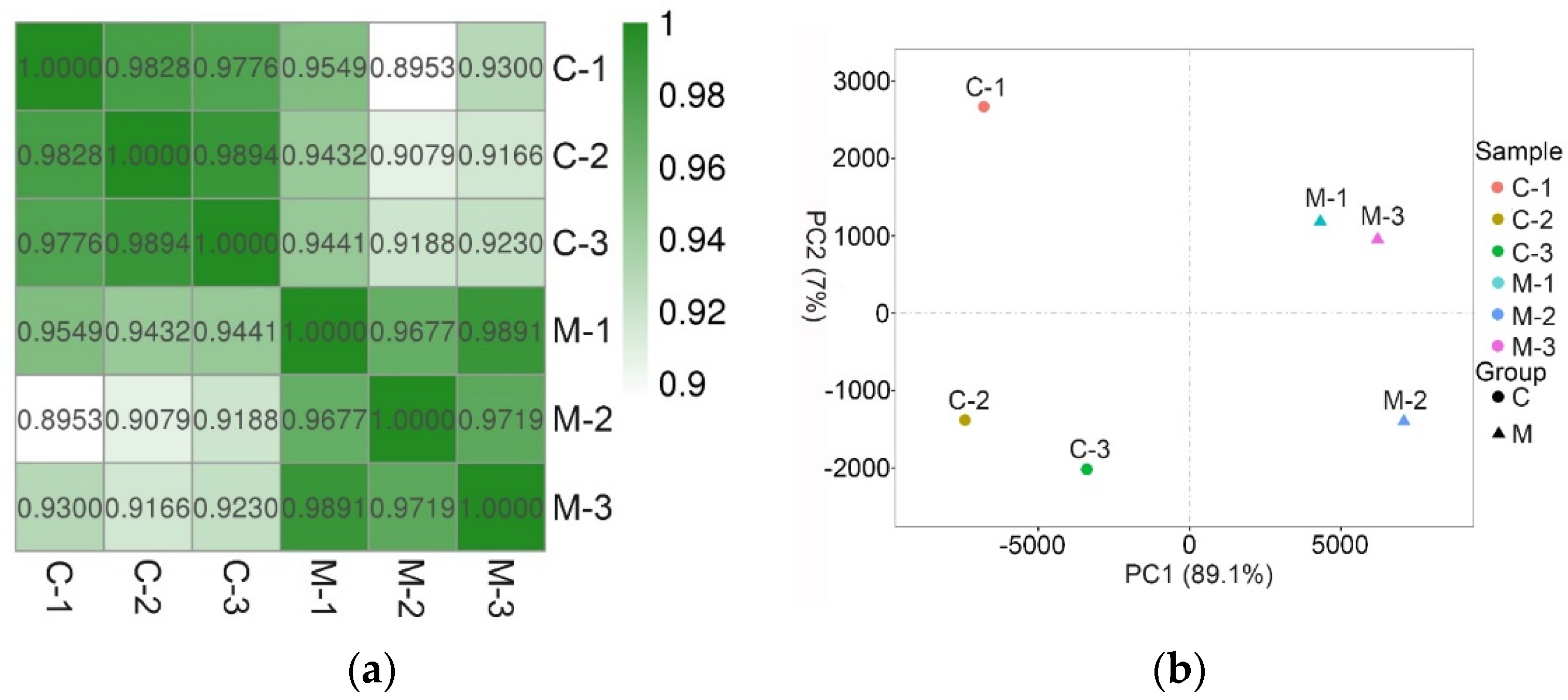
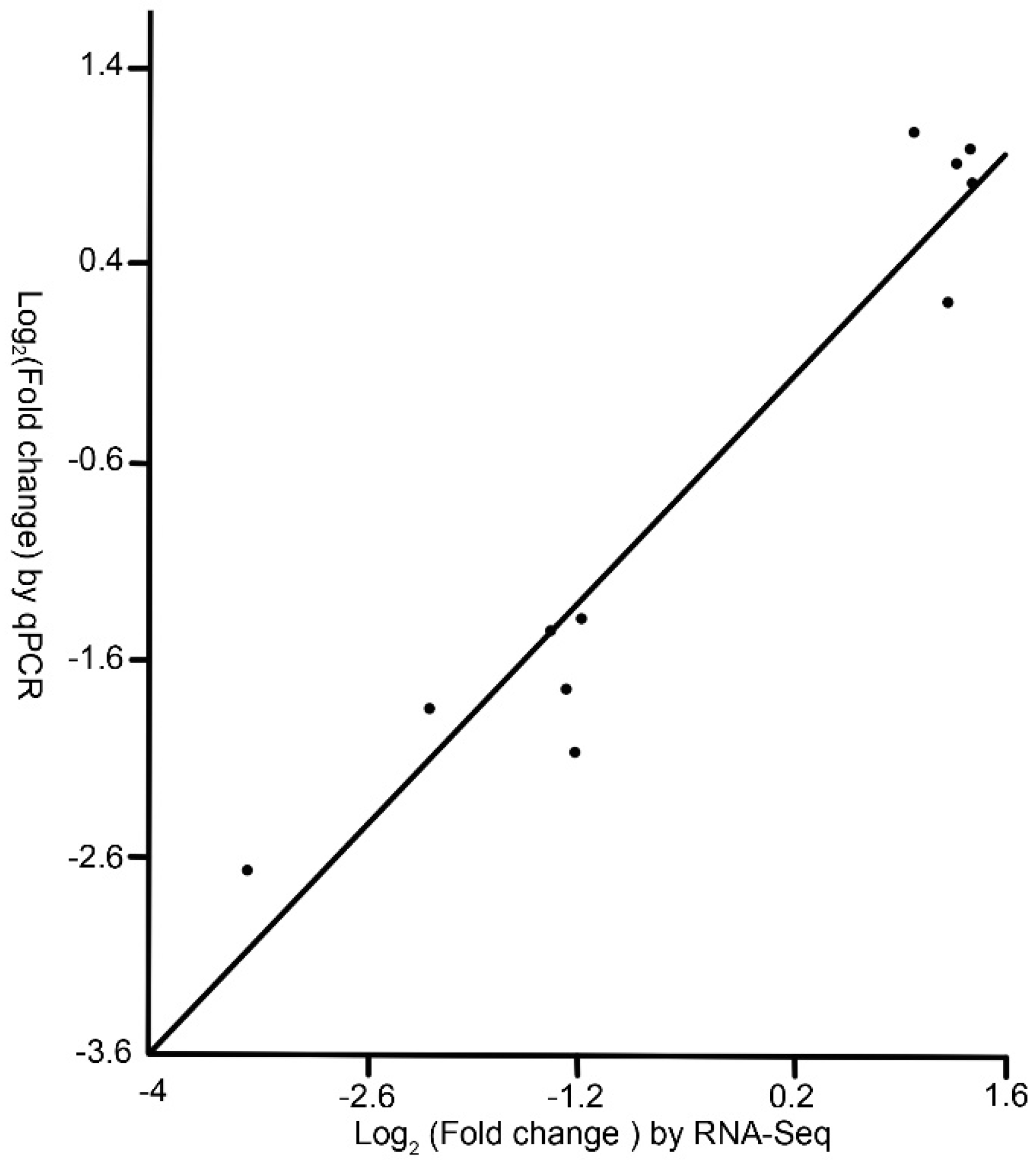
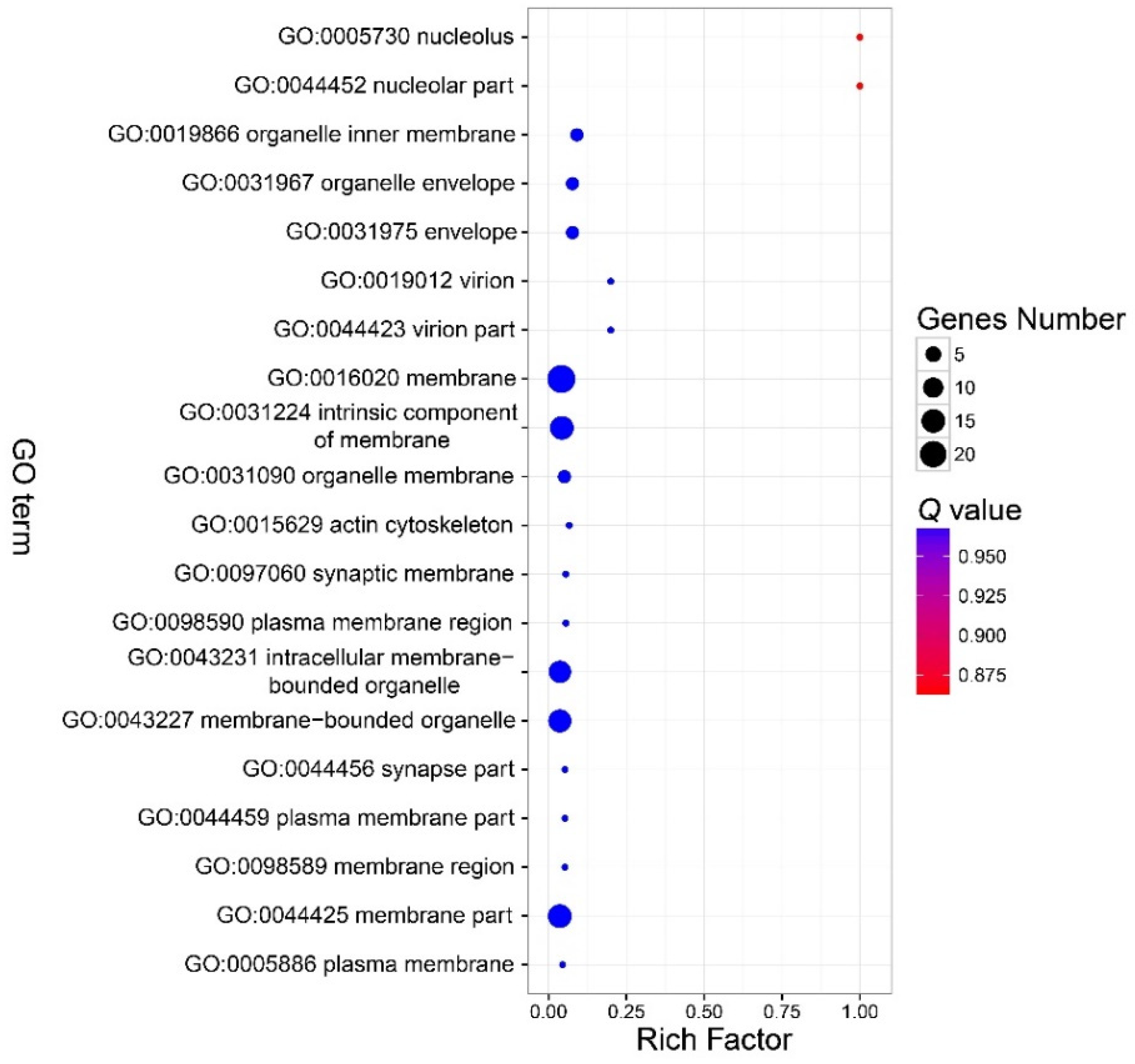
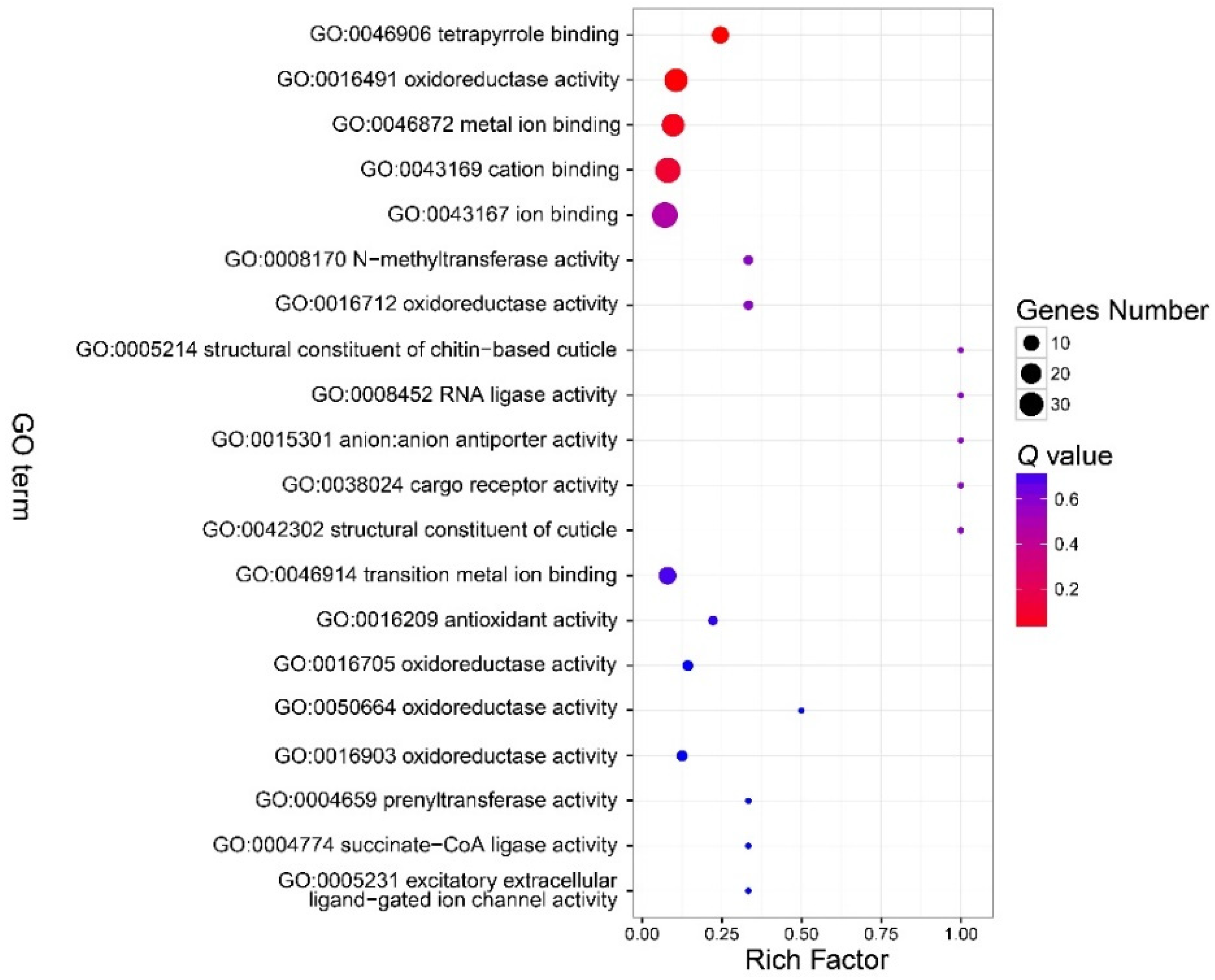
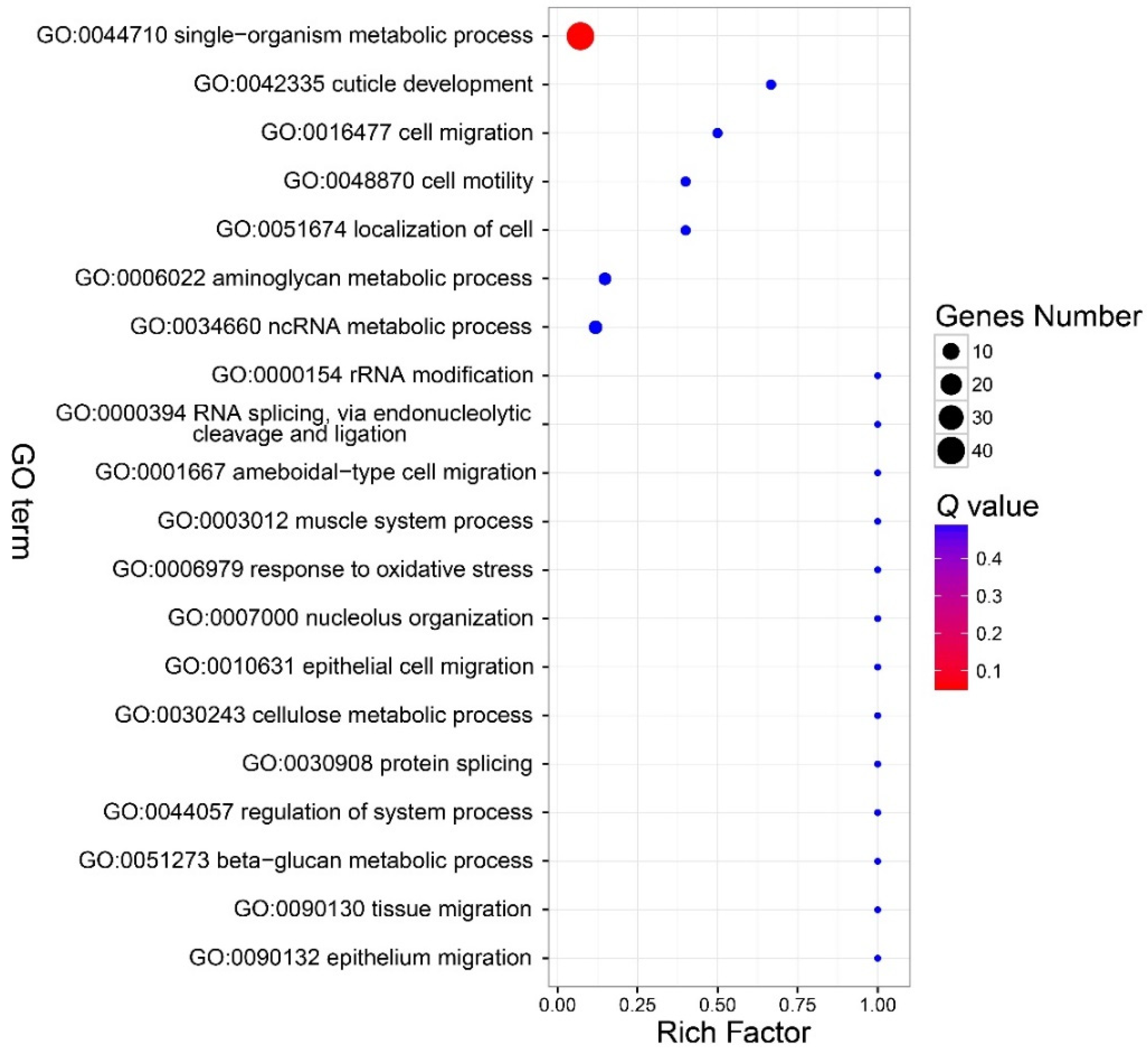
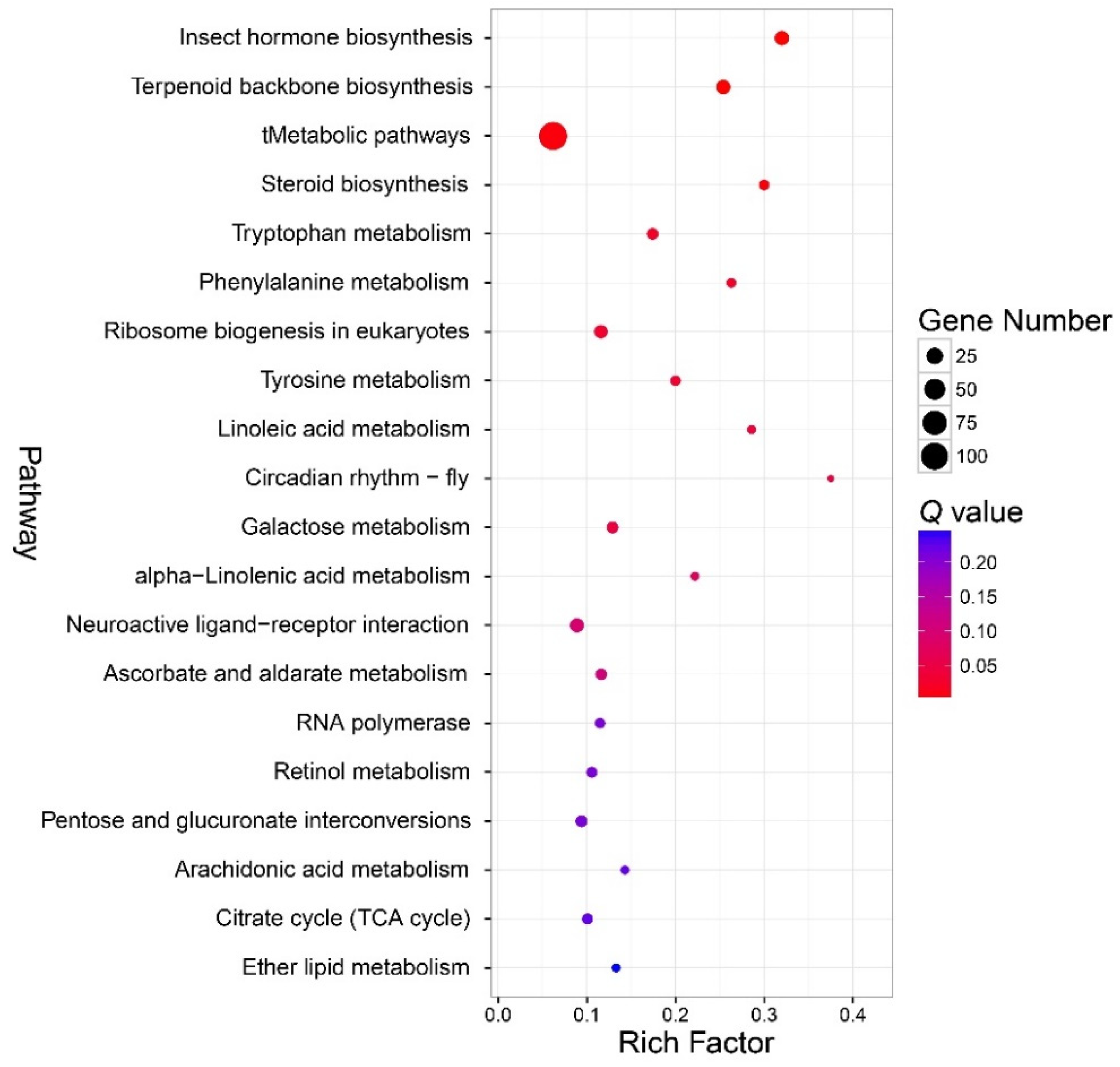
| Sample | Reads Len | GC | Adapter (%) | Low Quality (%) | Before Filter | After Filter | ||||||
|---|---|---|---|---|---|---|---|---|---|---|---|---|
| Reads Num | Data (bp) | Q20 (%) | Q30 (%) | Reads Num (%) | Data (bp) | Q20 (%) | Q30 (%) | |||||
| C-1 | 150 | 42.42% | 65,366 (0.15%) | 370,632 (0.43%) | 43,436,706 | 6,515,505,900 | 6,358,215,678 (97.59%) | 6,082,493,543 (93.35%) | 43,186,024 (99.42%) | 6,406,109,175 | 6,269,904,593 (97.87%) | 6,003,693,525 (93.72%) |
| C-2 | 150 | 42.74% | 77,716 (0.20%) | 332,628 (0.42%) | 3,9552,300 | 5,932,845,000 | 5,805,725,329 (97.86%) | 5,579,018,441 (94.04%) | 39,308,270 (99.38%) | 5,821,866,687 | 5,713,502,183 (98.14%) | 5,496,049,001 (94.40%) |
| C-3 | 150 | 42.56% | 73,332 (0.15%) | 395,232 (0.41%) | 48,329,198 | 7,249,379,700 | 7,101,010,753 (97.95%) | 6,830,421,183 (94.22%) | 48,058,250 (99.44%) | 7,132,398,497 | 7,004,858,972 (98.21%) | 6,743,894,191 (94.55%) |
| M-1 | 150 | 42.37% | 59,430 (0.14%) | 325,132 (0.37%) | 43,451,442 | 6,517,716,300 | 6,395,677,154 (98.13%) | 6,165,076,910 (94.59%) | 43,229,446 (99.49%) | 6,420,441,241 | 6,315,469,623 (98.37%) | 6,092,847,541 (94.90%) |
| M-2 | 150 | 42.46% | 127,050 (0.28%) | 500,052 (0.55%) | 45,789,528 | 6,868,429,200 | 6,711,965,107 (97.72%) | 6,442,092,243 (93.79%) | 45,412,452 (99.18%) | 6,734,642,039 | 6,602,981,101 (98.05%) | 6,344,371,629 (94.21%) |
| M-3 | 150 | 42.78% | 51,240 (0.12%) | 307,992 (0.37%) | 41,601,322 | 6,240,198,300 | 6,106,260,337 (97.85%) | 5,861,841,825 (93.94%) | 41,396,086 (99.51%) | 6,147,435,726 | 6,030,263,909 (98.09%) | 5,793,613,090 (94.24%) |
© 2020 by the authors. Licensee MDPI, Basel, Switzerland. This article is an open access article distributed under the terms and conditions of the Creative Commons Attribution (CC BY) license (http://creativecommons.org/licenses/by/4.0/).
Share and Cite
Du, H.; Tong, R.L.; Huang, X.; Liu, B.; Huang, R.; Li, Z. Methoprene-Induced Genes in Workers of Formosan Subterranean Termites (Coptotermes formosanus Shiraki). Insects 2020, 11, 71. https://doi.org/10.3390/insects11020071
Du H, Tong RL, Huang X, Liu B, Huang R, Li Z. Methoprene-Induced Genes in Workers of Formosan Subterranean Termites (Coptotermes formosanus Shiraki). Insects. 2020; 11(2):71. https://doi.org/10.3390/insects11020071
Chicago/Turabian StyleDu, He, Reina L. Tong, Xueyi Huang, Bingrong Liu, Runmei Huang, and Zhiqiang Li. 2020. "Methoprene-Induced Genes in Workers of Formosan Subterranean Termites (Coptotermes formosanus Shiraki)" Insects 11, no. 2: 71. https://doi.org/10.3390/insects11020071
APA StyleDu, H., Tong, R. L., Huang, X., Liu, B., Huang, R., & Li, Z. (2020). Methoprene-Induced Genes in Workers of Formosan Subterranean Termites (Coptotermes formosanus Shiraki). Insects, 11(2), 71. https://doi.org/10.3390/insects11020071





